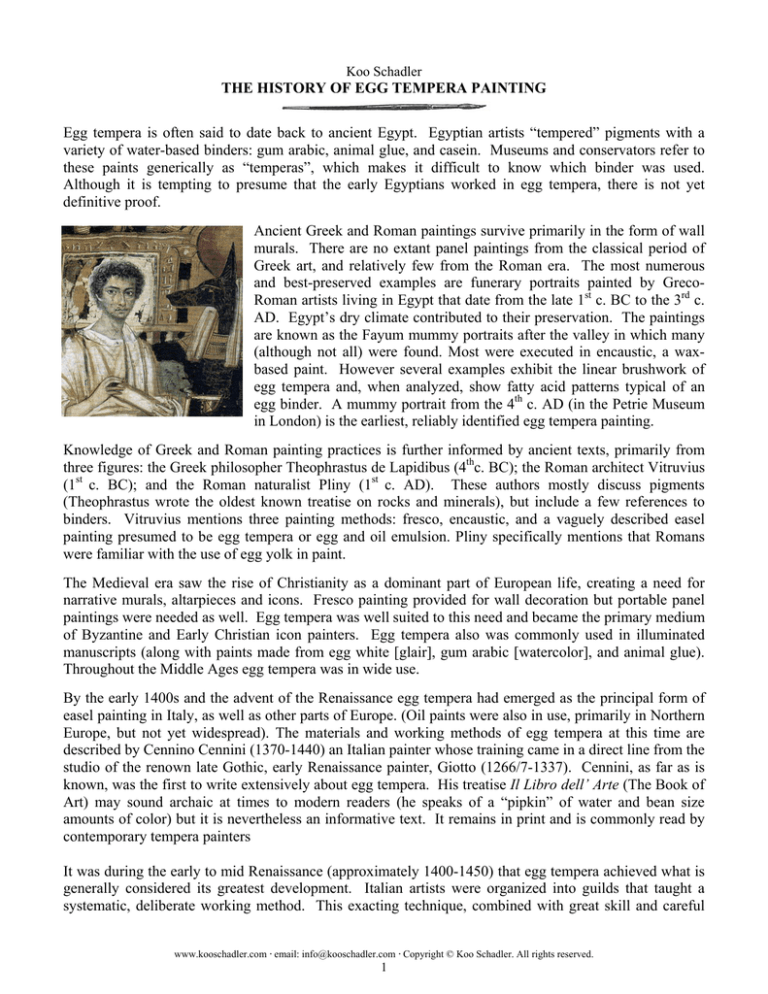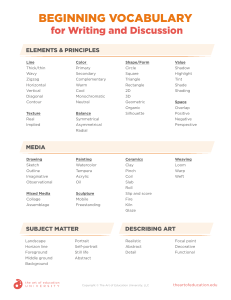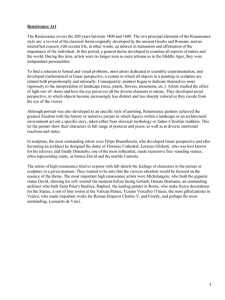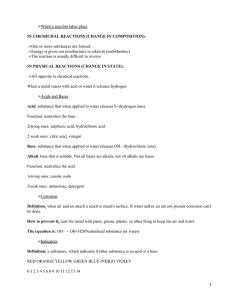THE HISTORY OF EGG TEMPERA PAINTING Egg tempera is often
Anuncio

Koo Schadler THE HISTORY OF EGG TEMPERA PAINTING Egg tempera is often said to date back to ancient Egypt. Egyptian artists “tempered” pigments with a variety of water-based binders: gum arabic, animal glue, and casein. Museums and conservators refer to these paints generically as “temperas”, which makes it difficult to know which binder was used. Although it is tempting to presume that the early Egyptians worked in egg tempera, there is not yet definitive proof. Ancient Greek and Roman paintings survive primarily in the form of wall murals. There are no extant panel paintings from the classical period of Greek art, and relatively few from the Roman era. The most numerous and best-preserved examples are funerary portraits painted by GrecoRoman artists living in Egypt that date from the late 1st c. BC to the 3rd c. AD. Egypt’s dry climate contributed to their preservation. The paintings are known as the Fayum mummy portraits after the valley in which many (although not all) were found. Most were executed in encaustic, a waxbased paint. However several examples exhibit the linear brushwork of egg tempera and, when analyzed, show fatty acid patterns typical of an egg binder. A mummy portrait from the 4th c. AD (in the Petrie Museum in London) is the earliest, reliably identified egg tempera painting. Knowledge of Greek and Roman painting practices is further informed by ancient texts, primarily from three figures: the Greek philosopher Theophrastus de Lapidibus (4thc. BC); the Roman architect Vitruvius (1st c. BC); and the Roman naturalist Pliny (1st c. AD). These authors mostly discuss pigments (Theophrastus wrote the oldest known treatise on rocks and minerals), but include a few references to binders. Vitruvius mentions three painting methods: fresco, encaustic, and a vaguely described easel painting presumed to be egg tempera or egg and oil emulsion. Pliny specifically mentions that Romans were familiar with the use of egg yolk in paint. The Medieval era saw the rise of Christianity as a dominant part of European life, creating a need for narrative murals, altarpieces and icons. Fresco painting provided for wall decoration but portable panel paintings were needed as well. Egg tempera was well suited to this need and became the primary medium of Byzantine and Early Christian icon painters. Egg tempera also was commonly used in illuminated manuscripts (along with paints made from egg white [glair], gum arabic [watercolor], and animal glue). Throughout the Middle Ages egg tempera was in wide use. By the early 1400s and the advent of the Renaissance egg tempera had emerged as the principal form of easel painting in Italy, as well as other parts of Europe. (Oil paints were also in use, primarily in Northern Europe, but not yet widespread). The materials and working methods of egg tempera at this time are described by Cennino Cennini (1370-1440) an Italian painter whose training came in a direct line from the studio of the renown late Gothic, early Renaissance painter, Giotto (1266/7-1337). Cennini, as far as is known, was the first to write extensively about egg tempera. His treatise Il Libro dell’ Arte (The Book of Art) may sound archaic at times to modern readers (he speaks of a “pipkin” of water and bean size amounts of color) but it is nevertheless an informative text. It remains in print and is commonly read by contemporary tempera painters It was during the early to mid Renaissance (approximately 1400-1450) that egg tempera achieved what is generally considered its greatest development. Italian artists were organized into guilds that taught a systematic, deliberate working method. This exacting technique, combined with great skill and careful www.kooschadler.com · email: info@kooschadler.com · Copyright © Koo Schadler. All rights reserved. 1 craftsmanship, produced a masterful body of tempera paintings (as evidenced by the many Renaissance works in good to excellent condition to this day). Works by Fra Angelico, Mantegna, Ghirlandaio, and Botticelli are examples of this technical and artistic virtuosity. Northern European painters were not as immersed in an egg tempera tradition, and their guilds were not as beholden to a particular school or working method. Northern Europe also had a history of an early form of oil painting behind it. Thus it was in the north that more experimental materials and methods began to develop. In his book on the lives of famous painters, the 16th c. historian Giorgio Vasari credits Flemish painter Jan Van Eyck with single-handedly creating the revolutionary technique of oil painting. In actuality the use of drying oils in easel painting can be traced back to a long and gradual development. Oils were used in decorative painting and as protective coatings throughout the middle ages, probably earlier. These early oils were generally dark, thick, and not well suited to easel painting. But by the 1400s texts began to appear describing how to refine drying oils to make them lighter in tone, faster drying and with better working properties. A commercial renaissance was taking place throughout Europe and with it came the distribution of the new materials, methods, and the paintings that resulted. By the late 1300s to early 1400s, northern European painters were working partly or entirely in oil. 1 Slow drying oil paints blend more readily than fast drying, linear tempera. This makes it easier in oil to paint smooth transitions and three-dimensional forms. Because of its higher refractive index, oil is capable of darker shadows than can be achieved in tempera. Whereas tempera must be applied in thin layers, oil can be applied thickly (impasto), which contributes opacity to lights and highlights and makes them “pop”. In other words, oil is better suited to creating natural light effects, atmosphere and more realistic imagery in general. Greater realism suited the less spiritually oriented, more scientific and humanistic culture of the Renaissance. Northern artwork purchased by Italian collectors began to travel southward. Italian painters were deeply impressed by the new work. They either emulated the aesthetics of the north, and/or adopted the new oil medium and working methods. Artists of the mid to late Renaissance painted in a variety of ways: - Some artists continued to work in pure egg tempera. Although Fra Angelico adopted northern aesthetics (lower chroma palette, more natural light effects), as is evident when his early and later work are compared, his medium remained traditional egg tempera (as well as fresco). - Other artists combined egg tempera underpaintings with oil overpaintings. An unfinished work by Michelangelo, The Manchester Madonna, 1497, shows a green earth underpainting done in egg tempera. It is likely that Michelangelo would have finished the work in oil since it was the emerging medium, it facilitated the rendering of form consistently evident in his work, and other paintings of Michelangelo’s from this period are in oil. - Some Renaissance paintings incorporate both mediums. A painter might use egg tempera for parts of an image with light values and/or cool color temperature, such as whites or blues (since tempera neither darkens nor yellows with age). Areas with dark values, such as blacks, were painted in oil (since darks in oils are more saturated and deeper than in tempera). Three Saints by the Pollaiolo brothers, painted in 1468, exemplifies this approach. - Some painters mixed egg yolk and oil together to create an egg and oil emulsion paint known as tempera grassa. Several Lorenzo Lotto paintings from the early 1500s that were analyzed in 2011 are said definitively to contain areas painted in tempera grassa. Botticelli’s Primavera, 1482, is believed to have been painted partly in tempera grassa.2 1 For more on the transition from egg tempera to oil, read my handout on this topic. There is uncertainty about the extent to which tempera grassa was used in the 1400s. No contemporary descriptions are known, and it is one of the most difficult mediums to analyze, for reasons outlined in National Gallery Technical Bulletin, Vol. 26, 2005. At this point, no Renaissance work painted fully in tempera grassa has been reliably identified; however some paintings appear to contain sections painted with an egg and oil emulsion. 2 www.kooschadler.com · email: info@kooschadler.com · Copyright © Koo Schadler. All rights reserved. 2 - - Still other artists started as tempera painters but converted fully to oil. Piero della Francesca was one of the first who began as an egg tempera master, was then introduced to oil, and soon adopted it as his primary medium. Artists also switched among the various mediums. Botticelli’s oeuvre includes many paintings of pure egg tempera, others partly in tempera grassa, some in pure oil. Botticelli’s work is at times described as “tempera and oil” – which doesn’t clarify whether it is tempera grassa, oil over tempera, or areas in tempera alongside areas in oil. 3 As is evident, the 1400s were an interesting era in western art history! Unfortunately the period is not yet well documented, studied or understood in all its complexity. The National Gallery in London is doing some of the best research in this area, and offers an excellent selection of technical bulletins (available on line as free downloads) and books on the subject. Images and descriptions of the museum’s extensive collection of Renaissance paintings are available from the Gallery’s website. The effects of oil were acclaimed in both north and south. By the advent of the sixteenth century the materials and working methods of oil painting were sufficiently developed, understood, and available to be used to good effect and began to predominate. Tempera fell out of fashion and out of use. Within a short time oil painting became the primary form of easel painting throughout Europe, and, with the exception of icon painters, egg tempera painting was virtually obsolete. One of the consequences of the preeminence of oil paint was the subsequent lack of knowledge of tempera, and the incorrect description (begun by Vasari and continuing to this day) of many Renaissance egg tempera paintings as oils. Confusion persists. I have seen Jan Van Eyck’s Giovanni Arnolfini and His Bride in the National Gallery in London described in different books as egg tempera, tempera with oil, and oil.4 To this day, leaf through an art history text or visit a museum and often you will find the caption under a Renaissance painting describe it simply as a “panel”, which describes what support was used but not which medium. Rarely are paintings listed as egg tempera; at best, a work might be labeled “tempera”, which doesn’t specify what binder was used, only that the paint was water-based. Hopefully improvements in technical analysis will lead to better documentation of mediums, especially considering the aesthetic and technical differences that exist between egg tempera and oil. In fact, considering the significant distinctions between the two mediums, it is surprising that there is not more discussion of the revolutionary change that occurred in the 1400s as artists transitioned from egg tempera to oils. Given the variety of mediums used during this period, how does one distinguish between an egg tempera painting, a work in oil, or some combination of the two? Scientific testing currently is limited in what it can discern. A combination of careful technical and visual analysis is needed to determine (not always precisely) what medium(s) were used. Additionally, many paintings have not been analyzed, and/or had the results of their analysis published. 3 Current technology can generally determine that both oil and egg proteins are present in a paint film, but can’t distinguish in what order they were applied, and/or if they were combined into a single paint (nor can conservators always distinguish between original paint layers and later restorations, done in different mediums, that have seeped into underlying layers). 4 The National Gallery in London, through recent analysis, now concludes that the Arnolfini painting is composed of “oil, probably with some egg tempera, on oak”. www.kooschadler.com · email: info@kooschadler.com · Copyright © Koo Schadler. All rights reserved. 3 Amidst the confusion, one can make the following generalizations: - Paintings prior to 1400 are most likely pure egg tempera. - Paintings from 1400 to 1500 are pure egg tempera, or some combination of tempera and oil, or possibly pure oil. The later in the 1400s the work was painted, the more likely it is oil (although not necessarily). More linear brushwork indicates egg tempera; more smoothly blended, atmospheric work indicates tempera grassa or oil. - By the early 1500s nearly all easel paintings were executed in oil (with the exception of icons). Although the icon painters continued to work in egg tempera, the medium mostly lay dormant for the next three hundred years. Then, in the 19th century, the English fell in love with Italy. Numerous Brits took up residence in Florence and began to explore the city’s archives. In 1844 an Englishwoman, Mary Merrifield, rediscovered, translated, and published Cennini’s 14th century manuscript, Il Libro dell’Arte. A second, more accurate translation appeared in 1899 by Christiana J. Herringham. At the same time, in response to the increasing mechanization of the Industrial Revolution, the Arts and Crafts movement in Europe and North American encouraged painters to experiment with handmade paints and traditional working methods. Inspired by these events, five British artists formed the “Society of Painters in Tempera” in 1901. The Society met, issued papers, and published articles to educate the public and raise awareness of egg tempera. Members painted in tempera and, beginning in 1905, held several exhibitions of their work. Efforts were made to re-identify many of the early Italian egg tempera masterpieces incorrectly labeled as oil. By the mid 1930s most of the original founders had dissipated and by World War II the society was inactive. However the revival of egg tempera painting had begun. British artist and egg tempera proponent Maxwell Armfield lived in America from 1915-1922, exhibiting his work and writing about tempera while in the United States. In 1920 Daniel Thompson, a professor at Yale School of Fine Art, began teaching a course in tempera, creating a new generation of egg tempera painters. A strong collection of early Italian art at the Yale Art Gallery augmented his teachings and further fueled interest. In 1936 Thompson published two books: his translation of Cennini’s manuscript, and The Practice of Tempera Painting, a contemporary description of the Italian Renaissance working method. Thompson’s books are still available and popular among tempera painters. Throughout the 1930s many notable American artists experimented with egg tempera or tempera grassa: Thomas Hart Benton, Isabel Bishop, Reginald Marsh, Ben Shahn, and John Sloan, to name a few. The leading 20th century practitioners of tempera include George Tooker, Paul Cadmus, Jared French, and Andrew Wyeth (who learned it from his broth-in-law, Peter Hurd). In 1973 a well-known egg tempera artist, Robert Vickrey, published a book on tempera painting entitled New Techniques in Egg Tempera. It discusses both traditional and nontraditional ways to work with egg tempera. Interest in egg tempera continues to grow. In 1997 artists Michael Bergt and Lora Arbrador formed a new “Society of Tempera Painters”. They developed a web site that offers information on the history, technique, and materials of tempera painting as well as examples of contemporary artists’ works. The website also has an interactive forum where people can ask questions and discuss topics on tempera. The mission statement for the new organization is the same as that of the original society: “The improvement in the art of tempera painting by the interchange of the knowledge and experience of the members”. www.kooschadler.com · email: info@kooschadler.com · Copyright © Koo Schadler. All rights reserved. 4



